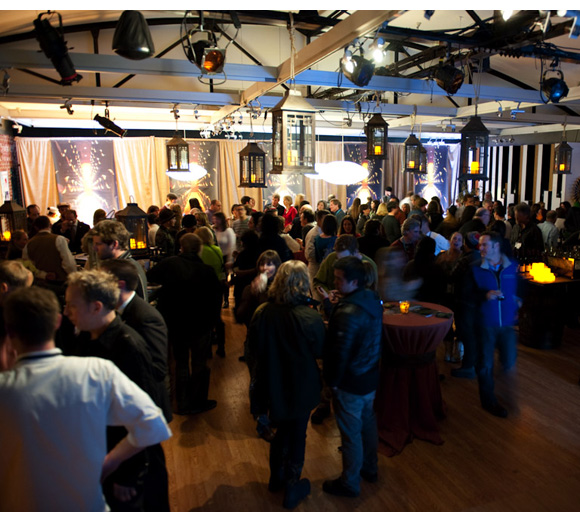Napa Grabs the Spotlight at Sundance
/One of the hottest tickets at Sundance 2011 wasn’t a film. Rather, it was the launch party for the Napa Valley Film Festival, which debuts this November 9–13. Sixteen Napa wineries came to Park City to pour the good stuff—90+ point, limited-production wines from Carneros to Calistoga—while celebrity chef Michael Chiarello was on hand to provide delectable small bites made to match. “We decided to bet the farm,” says festival cofounder Marc Lhormer of the classy kickoff. He and Brenda Lhormer ponied up to become an official Sundance Institute Associate, which enabled them to hold the tasting at the Sundance House and get word out to invited directors, agents, press, and other film industry movers-and-shakers. “We decided to buy a Super Bowl ad—to go out big and announce ourselves to the world,” Brenda Lhormer says of the Sundance venue.
The Sonoma-based couple are no strangers to the film scene, having produced Bottle Shock (2008), a riff on the legendary 1976 Judgment of Paris that put California wine on the map. They also took over the Sonoma County Film Festival in 2002 and ran that for seven years. “Bottle Shock got us involved with people in Napa, and they said, ‘Why does tiny Sonoma have this festival? Why don’t we have one?’” Marc Lhormer recalls. “So we said, ‘Let’s work on that.’”
While the Sonoma event was confined to the town of Sonoma, the new Napa festival will be much bigger, spread out over four communities: Napa, Yountville, St. Helena, and Calistoga. “Sonoma was almost an apprenticeship before moving on to the big stage,” says Marc Lhormer.
The Napa festival will showcase some 30 features that premiered earlier in the year at top indie film festivals. “Sundance is beginning of the annual calendar,” says Marc Lhormer. “Our intent with Napa is to close the year, showcasing the best films that premiered at Sundance or South by Southwest or Tribeca or the LA Film Fest. So we’re cherrypicking the best and complementing that with a sprinkling of films that come out between Thanksgiving and Christmas and have Oscar buzz.” These will be rounded out with 30 shorts, plus a program of student films from local high schools. The films will cycle between towns, playing at venues created specifically for the event. As in Sonoma, the organizers aim to “integrate food and wine into the film-going experience, both on the way in—with wine tastings in the lobbies of theaters—and afterwards,” Marc Lhormer says.
Working with the Napa Valley Vintners Association, the Lhormers corraled 16 wineries for the Sundance party, mostly boutique producers making only several thousand cases annually. The lineup included Allora, John Anthony, David Arthur, Cimarossa, Chiarello, Tom Eddy, Farella Park, Gargiulo, Gemstone, Matthiasson, Parallel Napa Valley, Salvestrin, and Staglin Family Vineyard, as well as Chimney Rock (one of Terlato’s many Stags Leap AVA properties) and Raymond Vineyard and Cellar (now part of Jean-Charles Boisset’s empire).
Among the room’s standouts was the Matthiasson 2009 Napa Valley White, a unique blend of Sauvignon Blanc with Ribolla Gialla and Tocai, two grapes native to Friuli in northeast Italy. Steve Matthiasson, a viticultural consultant for such Napa luminaries as Far Niente and Spottswood, is among the half-dozen producers in Sonoma and Napa working with Ribolla Gialla, a plump, yellow, acidic grape from the Collio region bordering Slovenia. These Ribolla grapes are from cuttings first brought to California by George Vare of Luna Vineyards, who took them from vineyards in Oslavia owned by the grand master of Ribolla himself, Josko Gravner. This blend—Matthiasson’s first white—is a gorgeous, mouthwatering marriage of stone fruit and minerality that rivals the best of Italy’s Collio Biancos.
More typical of Napa were the several excellent Bordeaux blends. The crowning achievement was Gargiulo’s G Major Seven Study, a cabernet-keyed symphony whose sustained note of acidity created a wine of great elegance and finesse.
Topping the list of Napa Valley Cabernet Sauvignons from the wonderful 2007 vintage was that from longtime grower John Anthony, who founded his eponymous label in 2003. His 100 percent cab showcased that vintage’s dark ripe fruit while adding an interesting savory backnote.
Cabernet usually doesn’t play nicely with appetizers, but Chiarello—host of Food Network’s Easy Entertaining and owner/chef of Bottega restaurant in Yountville—expertly supplied some harmonious companions, including a ground-lamb skewer flecked with onions and raisins that looked like a miniature gyros log but tasted like none other. Then there was his truffle, a squishy ball of chocolate, basil, and balsamic that combined to awesome effect. In addition to playing the chef, Chiarello was also presenting two of his own wines: a succulent Zinfandel from pre-Prohibition vines and a pure Ribolla Gialla.
Billing itself “1 part food, 2 parts wine, 3 parts film, 4 parts festival,” the Napa Valley Film Festival made a good impression on the wine and food front with this Sundance fete. In November, we’ll know whether all the component parts have come into harmonious balance, or whether this festival still needs time to evolve.






